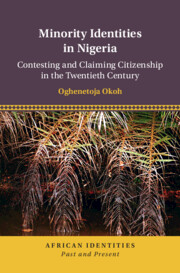Refine search
Actions for selected content:
869 results
Chapter 3 - Gender, Race, and Ethnicity: Effects on Conversation Memory
-
- Book:
- Conversation Memory
- Published online:
- 09 October 2025
- Print publication:
- 23 October 2025, pp 27-37
-
- Chapter
- Export citation
23 - Categorizing Music, Classifying People: Music Research and Race Studies in the Czech Lands
- from Part III - The Twentieth Century and Beyond
-
-
- Book:
- A History of Music in the Czech Lands
- Published online:
- 21 October 2025
- Print publication:
- 16 October 2025, pp 324-334
-
- Chapter
- Export citation
4 - The Mid-West Region
-
- Book:
- Minority Identities in Nigeria
- Published online:
- 26 September 2025
- Print publication:
- 16 October 2025, pp 135-164
-
- Chapter
- Export citation
2 - The Consolidation of Ethnicity in the Niger Delta
-
- Book:
- Minority Identities in Nigeria
- Published online:
- 26 September 2025
- Print publication:
- 16 October 2025, pp 60-95
-
- Chapter
- Export citation

Ancient Assyrians
- Identity and Society in Antiquity and Beyond
-
- Published online:
- 09 October 2025
- Print publication:
- 23 October 2025
Navigating Contentious Identities: Minority Women in Israeli Politics
-
- Journal:
- Journal of Race, Ethnicity and Politics , First View
- Published online by Cambridge University Press:
- 09 October 2025, pp. 1-38
-
- Article
- Export citation
The Political Implications of Identifying as a “Woman of Color” for Latina and Asian American Women
-
- Journal:
- Journal of Race, Ethnicity and Politics , First View
- Published online by Cambridge University Press:
- 06 October 2025, pp. 1-30
-
- Article
-
- You have access
- Open access
- HTML
- Export citation
Grammatical Variation in Namibian Afrikaans: Continuum or Ethnolinguistic Fragmentation?
-
- Journal:
- Journal of Germanic Linguistics / Volume 37 / Issue 3 / September 2025
- Published online by Cambridge University Press:
- 02 October 2025, pp. 308-323
-
- Article
-
- You have access
- Open access
- HTML
- Export citation

Minority Identities in Nigeria
- Contesting and Claiming Citizenship in the Twentieth Century
-
- Published online:
- 26 September 2025
- Print publication:
- 16 October 2025
Chapter 33 - Race and Empire
- from Part V - Afterlives and Future Fields
-
-
- Book:
- Michael Field in Context
- Published online:
- 03 October 2025
- Print publication:
- 25 September 2025, pp 315-323
-
- Chapter
- Export citation
Type 2 diabetes prevention in women with a history of gestational diabetes: addressing inequities in lifestyle interventions for women from socially disadvantaged cultural backgrounds
-
- Journal:
- Proceedings of the Nutrition Society , First View
- Published online by Cambridge University Press:
- 15 September 2025, pp. 1-7
-
- Article
-
- You have access
- Open access
- HTML
- Export citation
4 - Educating the Entitled
-
- Book:
- Ability and Difference in Early Modern China
- Published online:
- 10 September 2025
- Print publication:
- 11 September 2025, pp 82-114
-
- Chapter
- Export citation
9 - Turning Every Page
-
- Book:
- Ability and Difference in Early Modern China
- Published online:
- 10 September 2025
- Print publication:
- 11 September 2025, pp 212-230
-
- Chapter
- Export citation
3 - The Sovereign’s Man
-
- Book:
- Ability and Difference in Early Modern China
- Published online:
- 10 September 2025
- Print publication:
- 11 September 2025, pp 60-81
-
- Chapter
- Export citation
Conclusion
-
- Book:
- Ability and Difference in Early Modern China
- Published online:
- 10 September 2025
- Print publication:
- 11 September 2025, pp 247-251
-
- Chapter
- Export citation
1 - An Age of Decisions
-
- Book:
- Ability and Difference in Early Modern China
- Published online:
- 10 September 2025
- Print publication:
- 11 September 2025, pp 23-40
-
- Chapter
- Export citation
10 - Seizing Fortune
-
- Book:
- Ability and Difference in Early Modern China
- Published online:
- 10 September 2025
- Print publication:
- 11 September 2025, pp 231-246
-
- Chapter
- Export citation
Introduction
-
- Book:
- Ability and Difference in Early Modern China
- Published online:
- 10 September 2025
- Print publication:
- 11 September 2025, pp 1-22
-
- Chapter
- Export citation
2 - Dying for His Lord
-
- Book:
- Ability and Difference in Early Modern China
- Published online:
- 10 September 2025
- Print publication:
- 11 September 2025, pp 41-59
-
- Chapter
- Export citation
6 - Far from Home
-
- Book:
- Ability and Difference in Early Modern China
- Published online:
- 10 September 2025
- Print publication:
- 11 September 2025, pp 138-162
-
- Chapter
- Export citation
